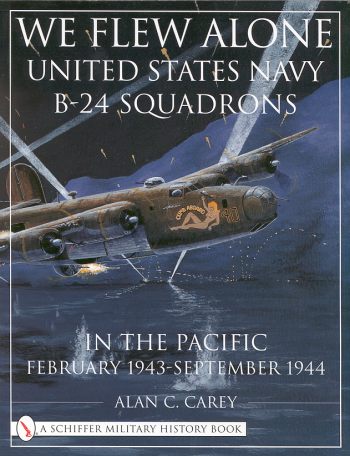
|
Title: |
We Flew Alone: USN B-24 Squadrons |
|
Author: |
Alan C. Carey |
|
Publisher |
Schiffer, 2000 |
|
Price |
$19.95 |
|
Reviewer: |
|
| Notes: | Card Cover |

I got this book as it looked to be most interesting and on a subject that I knew basically noting about. I also bought it sight unseen. With Schiffer books, this is very much a crap shoot. More times than you'd like, you'll find a book that is poorly edited and at times, totally useless. In my opinion, Schiffer is a book machine and cares more about cranking them out than it does about a decent job of editing. Now that may sound patently unfair, but talking with several authors who have had works done by Schiffer, I can tell you there is truth to that.
Anyway, this card covered book is 115 pages of print and pictures with about another 5 pages for 'notes'. In other words, they are blank. There is some white space, but not as much as in some other Schiffer books. There is no color other than the cover and no profiles. This was not intended as a book for modelers.
What it is, is a compilation of a number of unit histories into one format. Unlike the USAAF which kept squadrons/groups in theater for the duration, the USN rotated their bomber squadrons. General time in theater was about 6 months or so. When the squadrons left, they did not leave their aircraft for the next batch. That allowed them to be overhauled and repaired.
Needless to say, the missions they flew were mostly dull and monotonous. The bases were generally minimalist at best with the crews and maintenance personnel living in tent cities. When it wasn't the enemy that caused headaches, it was the weather or other environmental problems.
Most missions were flown alone and often planes never came back and no one ever found out why. A large mission may be three or four planes. One interesting thing I learned is that a great number of G4M Betty bombers were shot down by B-24 crews. When the planes would meet while on patrol, the faster and more heavily armed Liberators would eventually get the better of the lighter constructed and more poorly armored Bettys.
There are a rather goodly number of photographs in the book. Most are of the crews or the places they were based or attacked. Very few good aircraft photos are in there. Again, this is not a modelers book. The author does his best to make it interesting and for the most part he has succeeded. I had no trouble reading through it, though it isn't the type of book one reads in a single sitting. It is better to read it in sections.
The book itself covers until September 1944, by which time the PB4Y-2 Privateer arrived on the scene. Apparently that is being held for another book. There are several appendices at the end. The first is personnel lost in the line of duty. Next is a list of stats for each squadron covered. Finally, a listing of all B-24s (PB4Y-1) based in the Pacific by serial/unit and what its fate was (if known).
This is not a book I can recommend for the casual reader. Modelers who are looking for profiles and info for their next model should also look elsewhere. You really need to have an interest in the type or be a student of the Pacific war to find it interesting and it will reward you with some fascinating stories and a feel for what it was like to be stuck in the middle of nowhere during the war years.
Review book courtesy of my library.
If you would like your product reviewed fairly and quickly by a site that has well over 150,000 visitors a month, please contact me or see other details in the Note to Contributors.